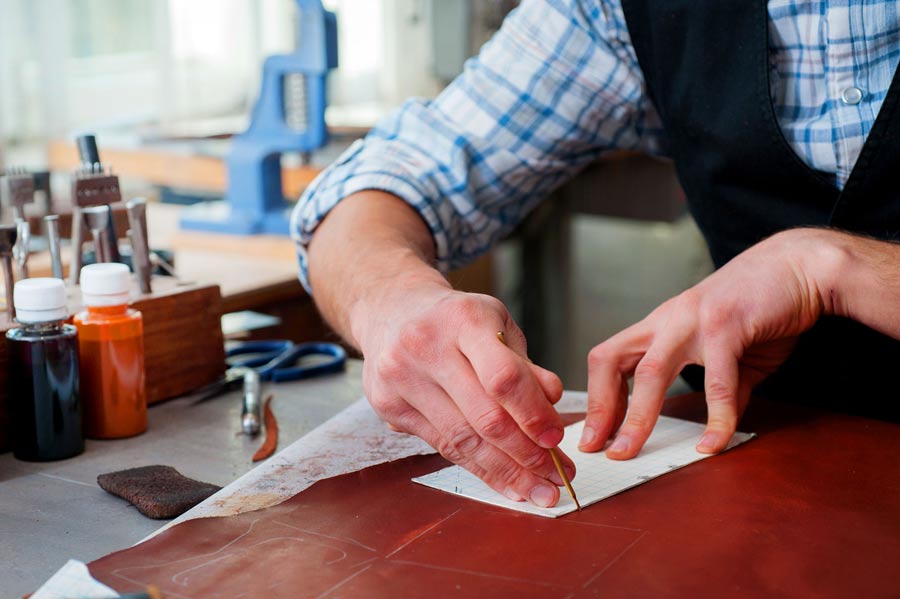
12 Jun What Are the Latest Innovations in Leather Crafting? Future-Ready Tools and Technologies
Leather crafting is an age-old art that continues to flourish in the modern world, adapting to new trends and technologies to stay relevant in a rapidly changing industry. As we delve into the realm of innovative tools, materials, and methodologies, it becomes clear how these advancements are reshaping the future of leather crafting, making it more efficient, sustainable, and versatile than ever before.
Modernized Traditional Leatherworking Tools
The evolution of traditional leatherworking tools has been nothing short of revolutionary. Today’s leather shops are increasingly equipped with modernized versions of old tools, incorporating advanced technology to enhance precision and speed. Computer-controlled cutting machines and robotic stitching systems now execute intricate patterns and designs with immaculate accuracy, vastly improving efficiency and reducing waste. This modernization represents a significant leap in production capabilities, enabling leather craftsmen to meet the growing demand for high-quality, consistent products while preserving the craftsmanship that defines the art of leatherworking.
Smart Materials and Functional Additions
The integration of smart materials into leather goods is a groundbreaking development. Imagine a wallet that not only holds your cards and cash but also allows you to interact with touchscreens thanks to conductive threads. Or consider self-healing leather finishes that repair scratches and cuts, extending the life of your favorite leather jacket. These functional enhancements not only boost the utility of leather products but also push the boundaries of what traditional leather goods can do.
3D Printing in Leather Crafting
3D printing is making waves in leather crafting, particularly in the areas of prototyping, custom tooling, and decorative embellishments. This technology allows for the creation of detailed and complex designs that would be difficult or impossible to achieve through conventional methods. The ability to print 3D models directly onto leather or to create custom molds for pressing intricate patterns into leather surfaces opens up new avenues for creative expression and customization in leather design.
Sustainable Leather Alternatives
As environmental concerns grow, the leather industry is responding with innovative, eco-friendly materials. Plant-based leathers made from materials like pineapple leaves, cork, and other organic resources offer a sustainable alternative to traditional leather without sacrificing quality or aesthetics. Additionally, the use of biodegradable dyes and tannins enhances the eco-friendliness of these products, appealing to a consumer base that values sustainability.
Digital Design and Prototyping Tools
The adoption of digital design software and virtual prototyping tools is transforming the way leather goods are conceptualized and created. These technologies enable designers to experiment with different styles, colors, and textures in a virtual environment, significantly speeding up the design process and reducing the need for physical prototypes. This not only saves resources but also allows for rapid iteration and innovation, helping designers bring their visions to life with greater accuracy and creativity.
Collaborations with Tech Companies
Increasingly, leather artisans are partnering with tech companies to create innovative products that blend traditional craftsmanship with modern technology. These collaborations often result in cutting-edge products that feature the best of both worlds—timeless leather artistry combined with the latest technological advancements.
Skills Training for the Digital Age
To ensure that the leather crafting industry continues to thrive, it is crucial to integrate digital skills training into traditional education programs for artisans. Numerous online platforms and workshops now offer training in the latest digital tools and technologies, empowering new generations of leather craftsmen to embrace these innovations.
Conclusion
The leather crafting industry is undergoing a profound transformation, driven by technological advances and innovative practices. By embracing these changes, leather artisans can enhance their craft, expand their creative horizons, and continue to produce exceptional, high-quality products. As we look to the future, the marriage of tradition with technology holds the promise of keeping this timeless craft vibrant and relevant for years to come.


